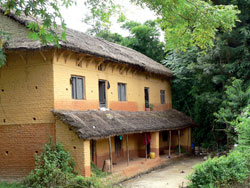|
|
For many of us, the mud houses dotting the skyline of rural Nepal are symbolic of poverty. But mud is on the comeback track internationally, as the material and bias against it are re-evaluated. There is interest in reviving it in Nepal, too.
Today, Kathmandu is almost overpowered by a concrete jungle. Existing concrete houses are not only ugly to look at, but also brutally expensive. They aren't earthquake-safe and are either too hot or too cold.
All this calls for an alternative model. And fortunately, we have the interest and the resources. First, we need to go adobe.
Adobe (pronounced a-doe-bee) is a mixture of sand and clay, and sometimes straw, poured into a rectangular form and left to bake in the sun. Sun-baked adobe bricks are thermally superior to kiln-baked bricks, cement, stones, wood, and straw, because they retain heat and cold better.
Until 30 years ago, adobe was the dominant building material in Nepal, and we have a rich tradition of such construction here. Most neo-classical Rana palaces were built out of adobe with only a thin fa?ade of fired bricks. Dharara is believed to be one of the tallest earthen structures in the world.
Adobe was abandoned in Nepal mainly because the ground floors, or chhindi, of adobe houses were so cold and damp that they could only be used to house domestic animals. Today we have a better understanding of organic and inorganic materials that can effectively block the cold from seeping in from the floor, making the ground floors of such houses thermally comfortable.
The old adobe houses also lacked indoor toilets. Outdoor toilets are more productive, since the waste is composted to make fertiliser, but unless updated, they are unlikely to cater to the modern sensibility. Italians have made a modern mud-plastered bathroom waterproof using linseed oil and beeswax.
In Kathmandu, a group of adobe enthusiasts from diverse professional backgrounds are researching and promoting mud, and what they call its 'soul mate', bamboo. The group, Abari (Adobe and Bamboo Research Initiative), says these materials could return to daily life.
Says Shishir Gairhe, one of the founders of Abari: "Our main idea is to have a portal, where anybody who wants to work with adobe or bamboo would get encouragement and resources. It doesn't matter where they want to make a sculpture or restore a house, if they have the interest we will help them."
Adopting adobe
Pros
. If properly designed, adobe is warm in winter and cool in summer.
. It is structurally versatile: adobe houses don't have to be linear and rectangular like those made with cement.
. Adobe stands forever if it has a good foundation, a good roof, and gets periodic maintenance.
. It is fire-resistant.
. The techniques and skills required for adobe construction are easily learned.
. Unlike cement, adobe absorbs toxic gases, making such houses safer and more hygienic.
. Life inside an adobe house is quieter, since it insulates sound.
. Wood is conserved, as vault or dome systems can be used for the roofs
. Adobe houses are cheaper and environmentally benign
. Properly designed adobe buildings are earthquake-resistant
. Due to the rich variety of Nepali soil, we can have extraordinarily beautiful exterior and interior plasters
Cons
. The floor needs damp-proofing with a moisture barrier like a sheet of thick plastic to wick moisture up through capillary action or creating a 'hanging' floor (called hawas in Nepali) or leaving an air gap between the soil and floor
. Adobe plaster needs to be regularly nurtured and in Kathmandu would need to be re-plastered every two years
. In Nepal, adobe houses symbolise poverty. This is a cultural bias because in places like Yemen, England, and New Mexico, having an adobe house is a status symbol.
Nripal Adhikary, an architecture consultant and documentary filmmaker, is also a founder of Abari. He can be contacted at nripal@yahoo.com.



